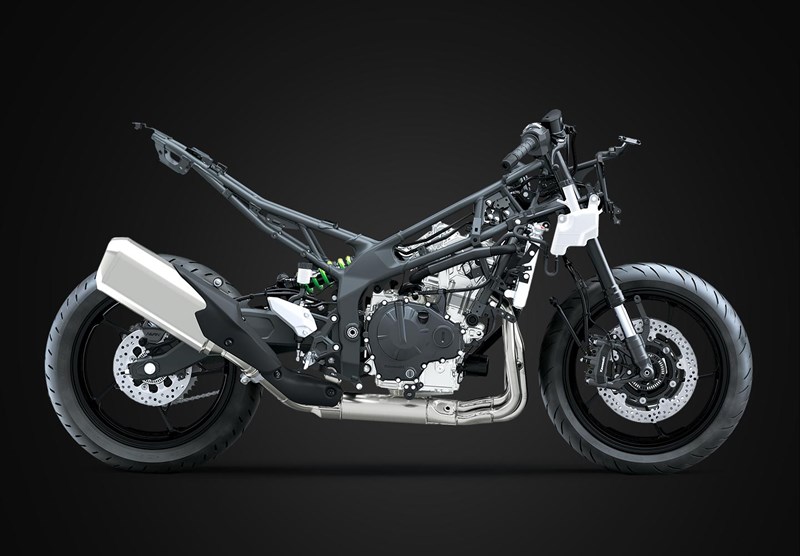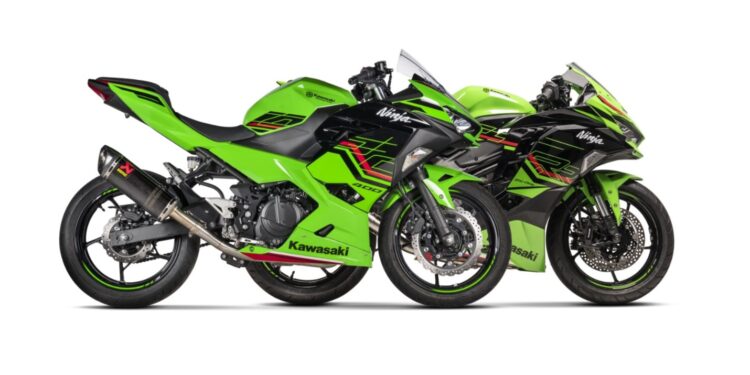Ninja 400 vs ZX-4R
We have not had a chance to get our hands on the new Kawasaki ZX-4R or RR. For those that do not know it’s one of Kawasaki’s latest motorcycles aimed at new and experienced riders.
To many Kawasaki’s new ZX-4R seems like something new and exciting but back in the late 80s and 90s there were many 400 cc four-cylinder Supersport motorcycles.
These little machines we fantastic motorcycles in everyway!!

It wasn’t just that they had screaming four-cylinder engines producing 150-160 horsepower per litre that made them special, but they also had chassis, suspension, and brakes designed for the race track.
This meant that these machines were quite literally miniature versions of the Superbikes of their day in almost every way.
These race replica 400 cc motorcycles were only officially sold in Japan but were imported to many Western countries as ‘Grey Imports’ where they were loved and adored.
They very quickly earned a cult following that persists to this day.
Machines such as Kawasaki’s very own ZXR400 as per above were very much machines built without compromise.

Powered by a 399 cc four-cylinder engine and produces a claimed 60 horsepower @ 12,000 rpm and 29.5 ft/lb at 10,000 rpm.
Weight was light too at around 160 kg dry.
With the above numbers on paper, the little Kawasaki ZXR400 is a quick little bike.
Then and today.
The Kawasaki ZXR400 can accelerate from 0-60 mph in around 3.7 seconds, 0-100 mph in around 9.5 seconds if piloted by a lightweight and competent rider.
This pocket rocket can also achieve a quarter-mile time that hovers around the low 12s with a terminal speed of 108-112 mph.
Depending on who is riding, the little Kawasaki ZXR400 will crack a genuine 140 mph top speed.
Today a Kawasaki ZXR400 would be comparable and in the same ballpark in performance as a Yamaha YZF-R7.
Where did the Mini 400 cc Race Reps go?
In recent times pretty much all sub 600 cc sports motorcycles and many sub 700 cc motorcycles (except 600 cc Supersport bikes) have been shipped with two-cylinder engines.
Predominantly parallel two cylinders.
There are various reasons for this but mainly due to the low cost to produce and the simple packinging of these engines.
For many of the parallel two-cylinder machines we’ve seen in recent times, their chassis, suspension, and brakes that they are equipped with are more budget-orientated than specifically for carving up Corners.
That doesn’t mean to say that they don’t handle well, instead, they provide a good balance between user-friendliness, comfort, and capability when upping the pace.
This current breed of mid to smaller-capacity sport motorcycles is much less focused and more user-friendly than the 400 cc race reps of the 90s.
Some of the most popular of them among the many parallel two-cylinder sports motorcycles are Kawasaki’s very own Ninja 400 and Ninja 650.

Both the Kawasaki Ninja 400 and Ninja 650 are wonderful machines that are aimed at new and intermediate riders.
Looking at the Ninja 400 specifically, It is also powered by a Parallel Two-cylinder 398 cc engine producing 45 horsepower and 28 ft/lb of torque.
It is very light at only 166 kg dry.
With its lightness and decent power It has more than enough performance to make it fun and to keep up with larger motorcycles on most roads.

Why another 400 cc Sportbike from Kawasaki?
To be honest, I didn’t think that we would ever see a small-capacity four-cylinder motorcycle again, but both Honda and Kawasaki gave us the CBR250RR and the Kawasaki ZX25R.
Honda was the first to reintroduce to the mark some tiny four-cylinder mayhem a little while back in 2017, and then Kawasaki followed in 2020.
The former produces more than 40 horsepower and the latter produces more than 50 horsepower and revs to a wild 16,000 rpm!
There has always been an appetite for small-capacity four-cylinder motorcycles, however, likely, the interest and subsequent success of both Kawasaki and Honda’s new 250 cc four-cylinder motorcycles confirmed this fact to both respective manufacturers.

While Honda was first off the mark reviving the 249cc inline-four with their CBR250RR, it appears Kawasaki aspired to be the first to reintroduce us to the joys of 400 cc four-cylinder ludicracy.
So in 2023, Kawasaki introduced to us the ZX-4R and ZX4RR which came as a massive surprise.
What is very surprising and refreshing is that Kawasaki did not hold back at all.
The proof is we didn’t get some subdued 400 cc four-cylinder producing much less power than it otherwise could.

The Kawasaki ZX-4R and ZX4RR are the most powerful 400 CC motorcycles ever!
Instead, looking at the numbers we see 76 horsepower claimed at the crank/ This is quite a bit up on the Kawasaki ZXR400 and any other 400 cc Supersport to date.
If I am correct the Kawasaki ZX-4R and ZX4-RR are the most powerful 400 cc 4-stroke motorcycles ever.
At the rear wheel, we see these machines producing 70 solid horsepower. It’s very impressive. and we thank Kawasaki for not holding back.
ZX-4R vs ZXR400 vs Ninja 400 specs comparison
| Model | ZX-4RR | ZXR400 | Ninja 400 |
| Power | 76 @ 14,500rpm | 59 @ 12,500rpm | 49 hp 10,500pm |
| Torque | 28.7 lb.-ft. @ 11,000 rpm | 29.5 @ 10,000rpm | 28 ft/lb 8,000rpm |
| Wet Weight | 189kg | 177kg | 166kg |
| 0-60 mph | 3.5 | 3.7 | 4.14 |
| 0-100 mph | 8 | 9.5 | 11.9 |
| 0-120 mph | 13.5 | 16 | N/A |
| SS/QM | 12.1@115mph | 12.5@ 110 mph | 12.98 @ 102 mph |
| Top speed | 150 mph (est) | 140 mph | 116.7 mph (120 mph) |
What is more powerful, the Ninja 400 or the ZX-4R?
Here is how the Kawasaki ZX-4R dyno graph looks compared to the Ninja 400.
Note: The US-spec models are restricted due to more restrictive emissions and will generally produce approximately 10 horsepower less at the rear wheel.
The differences are stark with the four-cylinder Kawasaki ZX-4R producing 71 horsepower at the rear wheel and the Kawasaki Ninja 400 with only 44 horsepower.
The torque produced by both machines is the same at 27 ft/b.

Engine Power: Ninja 400 vs ZX-4R
| Model | ZX-4RR | Ninja 400 |
| Power | 71@ 14,500rpm | 44 hp 10,000pm |
| Torque | 27 ft/lb @ 12,500 rpm | 27 ft/lb @ 8,500rpm |
If we look closer at the dyno graphs we can see that the Kawasaki Ninja 400 has a significant advantage in terms of power and torque from tick-over all the way to 9500 rpm.
We are looking at a 5-7 horsepower and torque advantage which is quite significant for smaller engines that share the same capacity.
It’s only beyond that point where the ZX-4R takes command and streaks ahead and produces more power and torque to a wild 15,000 rpm.
The Kawasaki Ninja 400 still revs to an impressive 12,000 rpm but its power and torque level off and then drops off way before it reaches its rpm limiter.

Ninja 400 vs ZX-4R in-gear acceleration
While we have not directly compared these machines on the road, the above in-gear thrust curve can give us a good idea of how they might stack up in certain gears and at certain speeds.
| Speed at 5000 rpm | ZX-4RR | Ninja 400 |
| 1st | 17,6 mph | 18.8 mph |
| 2nd | 25.1 mph | 26.8 mph |
| 3rd | 31.8 mph | 34.1 mph |
| 4th | 38.6 mph | 41.4 mph |
| 5th | 44.6 mph | 47.8 mph |
| 6th | 49.7 mph | 53.2 mph |
Surprisingly, it appears that both machines use the same gearbox, or Kawasaki opted to equip the Kawasaki ZX-4R with the same ratios as the Ninja 400.
Well, the internal gears appear to be the same with the difference being the primary and final drive ratios.
This means that the ZX-4R has slightly lower gearing than the Ninja 400 as demonstrated by the in-gear speeds with both machines at 5000 rpm.
To me, this appears a little strange be a strange choice and I would argue that the ZX-4R is slightly over-geared despite being lower geared than the Ninja 400.
But I am sure Kawasaki had their reasons, besides many of their Supersport machines have for a long time had longer gearing in most gears than competitors.
The Kawasaki ZX-10R is a good example of this, in particular the 2011 model.

If we go back and take a look at the above thrust curve, we can see that the Kawasaki Ninja 400 produces almost the same peak thrust/acceleration in each gear as the ZX-4R does.
This is despite the Ninja 400 producing 27 horsepower less! How is this possible you ask?
Well, both machines produce almost identical peak torque and have almost identical gear ratios.
The thrust curve is effectively torque multiplied by the gear ratios. So when we consider that fact, it is no surprise that their peak thrust/acceleration would be the same.
The in-gear Acceleration/Thrust graph being used takes into consideration the weight of each machine.
If it did not, the ZX-4R would produce more thrust because it does have slightly lower gear ratios but the Ninja 400 is a lighter machine which levels things up.

How will the Ninja 400 and ZX-4R compare on the road?
We will never know for sure unless tested back to back but as mentioned the thrust curve can give us some good insight.
Simply, the Ninja 400 will be a punchier machine most of the time and in most gears, especially at more moderate speeds and if rpm is below 9,500.
This is because the Ninja 400 produces more power and torque at lower rpm than the ZX-4R.
This also is demonstrated in every gear below a certain speed.
For the most part, the Kawasaki ZX-4R will need to be in a gear lower to match or beat the Ninja 400 in a roll-on situation.
But if both machines are in the same gear at anywhere close to 9000 rpm the Kawasaki ZX-4R will be much stronger.
However, at higher speeds of 70 mph/112 km/h the ZX-4R will need fifth gear to match the acceleration of the Ninja 400 in sixth gear, and will only start to accelerate faster once speeds hit 95 mph
At this point, the Ninja 400 will already be out in front.
So which is faster, the Ninja 400 or ZX-4RR
The obvious answer to this question is that the Kawasaki ZX-4R is a faster machine.
If we compare the 0-60 mph time between Ninja 400 and ZX-4R? Time will be similar in most instances but the outright potential of the ZX-4R would put it around 0.5 seconds faster with equally skilled riders.
Due to the peaky nature of the ZX-4R engine and lack of low-down torque, it probably would be more of a challenge to get a good 0-60 mph time.
Beyond 60 mph the ZX-4R will comfortably pull away from the Ninja 400. It would not even be close I’m afraid.
On a good day, the Kawasaki Ninja 400 can hit a top speed of 120 mph, even a little more perhaps, while the ZX-4R can hit 140 mph.

Because I previously pointed it out, you may have noted that both of these machines produce the same peak thrust/acceleration in each gear.
So you may now be thinking to yourself that the Ninja 400 and ZX-4R should accelerate broadly at a similar level.
But of course they don’t the ZX-4R is likely to be considerably more accelerative than the Ninja 400.
This is because the ZX-4R produces its peak thrust/acceleration at higher speeds and over a longer speed range than the Ninja 400.
It can do this thanks to its ability to rev much higher than the Ninja 400 and produce its peak torque at much higher rpm.
The ZX-4R then can hold on to its torque for longer and over a wider rpm range.
So with almost identical gearing it makes sense that the ZX-4R will produce its peak thrust/acceleration at higher speeds in the same gear compared to the Ninja 400.
If the Kawasaki Ninja 400 could hold onto its torque at a similar rpm as the ZX-4R, then it would produce a similar horsepower. 71 vs 44.
Remember, power is just torque multiplied by rpm / 5252.
That’s why to make more power from an engine the most effective way is to make it rev higher and produce as much torque as possible at high rpm.
The Ninja 400 produces much less torque at 12,00 rpm than the ZX-4R and thus produces less power at 12,000 rpm as a result.
In the coming months, we will do our best to get our hands on Kawasaki’s wonderful new ZX-4R put it through its paces, and perhaps run both machines back to back.




















